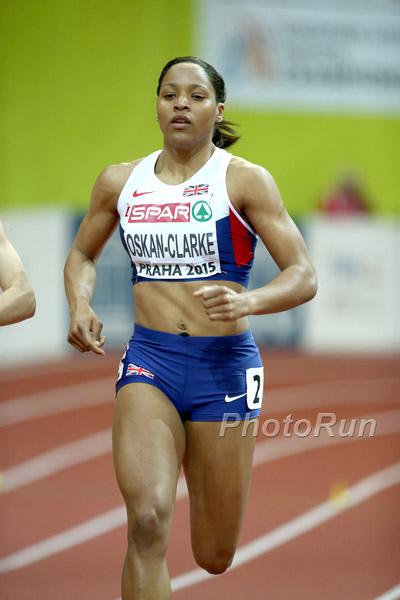What is fascinating to me, about our sport, is the wonderful people in it, the human capital of athletics. All of our successes and failures begin and end with the human capital of athletics. I learn to respect the hard work and challenges for coaches, athletes, managers, offiicals, and yes, fans in our sport.
Stuart Weir is all about giving you, the reader a view that he has seen in his travels and interactions with his fellow travelers, the athletes of GBR.
RelatedPosts
Here’s his thoughts on an admitted favorite, Shelayna Oksan-Clarke.
 Shelayna Oksan-Clarke, photo by PhotoRun.net
Shelayna Oksan-Clarke, photo by PhotoRun.net
Shelayna Oskan-Clarke
Shelayna Oskan-Clarke is the GB captain – see separate post on what that means. She is also an athlete I admire a great deal for her attitude and perseverance as much as well as her talent.
In 2008 she came fifth in the 400 metres in the Commonwealth Youth Games in India. Delighted with the performance, little did she realize that she would wait seven years before being selected for her first senior championship.
She is very honest about that period: “The transition from Junior level to Senior level seemed to take a while. I went the Youth Commonwealth for the 400 and I think my PB was 54.3 and I don’t think I ran another PB. I didn’t really progress”.
While others may have had doubts, Shelayna’s self-belief never wavered. In 2015 she ran for GB in the European Indoor Championships but made little impression and then ran 1:58:99 to take fifth place in the World Championships in Beijing, having run 1:58:86 (a PB) in the semi-final.
The 2015 was a vindication of her self belief, she explains: “One of the reasons I stuck at it seven years – quite a long time – was that I knew I had potential to be one of the best in the world. So Beijing 2015 wasn’t a surprise to me. I was more happy and relieved that it had come out but for a lot of people it was as if I had just rocked up! And all the sacrifice – working and travelling to training – all paid off”.
In 2017 she took silver in the European Indoors in Belgrade, losing to Selina Bűchel by one hundredth of a second. She reflects on Belgrade with mixed feelings: “When I look back on it, it was a time when I stepped up and proved to myself what I can achieve. On the final itself I am still a little disappointed at some of the tactical decisions I made. But I still came away with the medal and a belief that I can achieve more on the track”. She adds: “I am very critical of myself. I like to analyse my performance. So I try to analyse, reflect on it and then try to move on and input that into the next race”.
Shelayna is what you might call a converted indoor runner. She said: “Initially I did not like indoor running. I used to find it quite hard but now I think I have established a format that works for me. And it is about executing it on the day. Now I do enjoy it because I’ve had some achievements on the track. I enjoy it a lot more but I still have a lot to learn”.
As is often the case, it was a bad race – in the 2015 European Indoors – that made her better: “2015 was a turning point for me. I came back from the Indoors really disappointed – more because of my performance than my time. I let the other girls dictate the race for me in the heat and the outcome was not good for me. I vowed to myself that from that day I was not going to go into a race and let people dictate but I was going to go into a race and do what I wanted to do”.
She is now much clearer about how to run indoors: “Indoor races are more physical. In an indoor race when you’re in a bad position it harder to get out of it so it is best to get in the right position at the start. It is just a lot harder to make up ground if you are in the wrong position because it is so tight. So for me it’s about trying to get out into a good position at the start and maintaining the position throughout the race”.
Author

Since 2015, Stuart Weir has written for RunBlogRun. He attends about 20 events a year including all most global championships and Diamond Leagues. He enjoys finding the quirky and obscure story.
View all posts




















